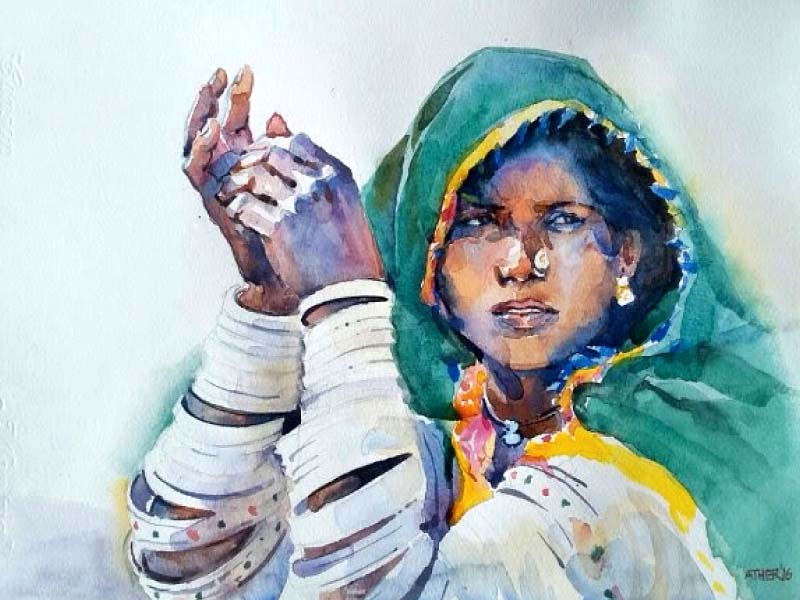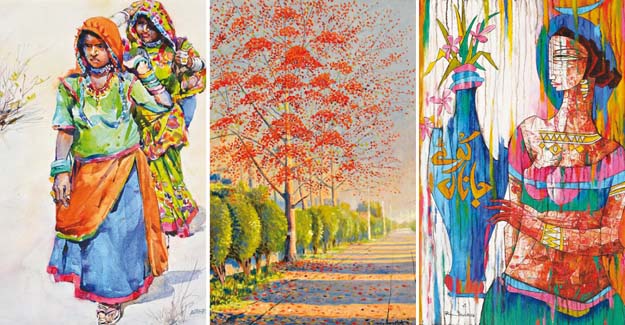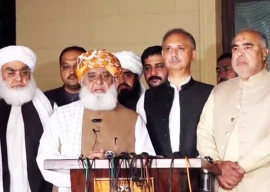
This is the common running theme for seven veteran artists whose works were put up for display at Gallery 6 on Saturday.
The exhibition, titled “Buoyant Assemblage”, showcases the works of Abrar Ahmed, Athar Jamal, AS Rind, Ghulam Mustafa, Shammi Ahmad, Wahab Jaffar and Masood A Khan.
The paintings of these artists, though, go beyond just an interpretation and rendition of the female form as they explore it in a vivid spectrum of colours.
Abrar, a self-taught artist, has become a mainstay of the art scene in Pakistan for the larger part of three decades. He usually paints women with elements of romance and beauty in his own unique style.
In this exhibition, Ahmed contributed five paintings. However, in these paintings he departs a little usual figurative style, shifting more towards portraits, stylising them with elongated necks, expressive eyes and eloquent hands. He also makes use of imagery such as birds, moon, musical instruments, and jewellery.
He also experiments with his medium with three of his works painting in acrylic on canvas while the other two oils on paper, a departure from his usual medium of oils on canvas.
Ather is largely credited with adding colour to the drab, monochromatic scenes of the Thar desert, documenting the life, clothing, homes and customs of what seems to be a region frozen in time.

Contributing five of his traditional watercolour paintings to the exhibition, he reconstructs the average Thari women through the colours they wear and the lives they live. While three of his paintings focus on the women, two of the paintings show a general landscape of a Thar village, seen through his lens of colours and lines.
On the other hand, Rind brought a splash of colours and forms from the south of Punjab. His signature composition of female forms includes with distinct faces reflecting the moods of his subjects all the while adorned with ethnic jewellery.
Ghulam, who has evolved a more ‘plein-air’ style, departs from the female form, keeping it in line with his more usual subject of urban landscapes from the streets of Lahore, documenting the interaction of the new, modern parts of the city with older parts of the metropolis.
Unlike the rest of the artists in the exhibition, Masood paints a more x-ray blueprint of settlements – rural or urban - showcasing the typical surroundings where one is most likely to encounter them.
His three paintings in the exhibition are done in grout - a mixture of water, cement, sand, gravel and colours.
Shammi, a student of legendary painter Jamil Naqsh, has contributed four paintings from her recent work in the exhibition. Titled “Beauty is Eternal”, they are portraits of women. While other artists build in expression through a concerted use of lines and features, Shammi uses colours and manipulates tones to offer moods.
Veteran artist Wahab has long been known to have experimented with the female form and colours. Drawing on from his mentor Ahmed Parvez, he brings in a full pallet of colours to his works. His smooth lines, colour coordination and balanced compositions render the image in a sharp and effective manner.
The exhibition will continue till December 24.
Published in The Express Tribune, December 18th, 2016.
1730793476-0/bella-(1)1730793476-0-405x300.webp)

1723119450-0/jlo-ben-(6)1723119450-0-165x106.webp)

1730270970-0/BeFunky-collage-(84)1730270970-0-165x106.webp)



1730786905-0/£300,000-(1)1730786905-0.png)






1730706072-0/Copy-of-Untitled-(2)1730706072-0-270x192.webp)
COMMENTS
Comments are moderated and generally will be posted if they are on-topic and not abusive.
For more information, please see our Comments FAQ